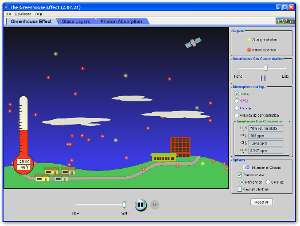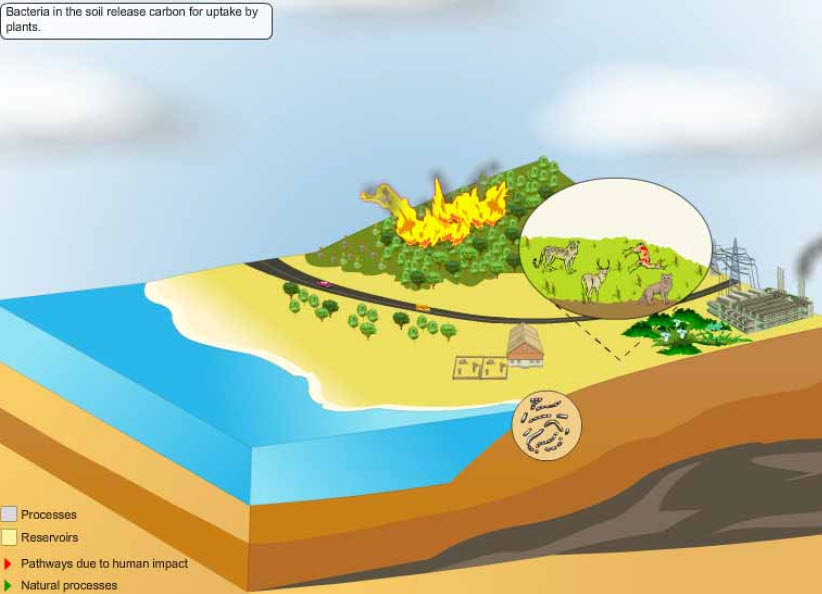Carbon in the Atmosphere
We've all heard about global warming and increasing levels of CO2 in the atmosphere. Take a look at the graph below.

Looking at the graph we can see that in 1960, the CO2 level was approximately 320 parts per million (ppm). In 2005, it had increased to 377 ppm.
Why is this increase worrisome? Even though CO2 makes up less than 0.1% of the Earth's atmosphere, it is the main greenhouse gas. Greenhouse gases (which include methane, nitrous oxide, water vapor, and sulfur dioxide, among others) allow solar energy from the sun to enter the atmosphere, but prevent some of it from being reflected back out into space, thereby keeping the planet warm just like a greenhouse allows solar energy in through the glass, then traps it, providing a warm environment in which plants can thrive.
The greenhouse effect is crucial for supporting life on Earth, but it relies on a very small amount of greenhouse gases. Any more than the small amount and too much heat is trapped, warming the Earth to the point where other natural systems and their cycles are seriously altered or disrupted.
Greenhouse Gases
Take a look at th Greenhouse Simulation of the greenhouse effect as it compares greenhouse gases today, in 1750, and during the Ice Age.
Record your observations from this simulation and reflect on the question in your science journal.
What differences do you notice with respect to H2O, CO2, CH4 and N2O concentrations?
The program will take a couple of minutes to open. If you have difficulty, go directly to http://phet.colorado.edu/en/simulation/greenhouse
Or select "Click to Run" below:
Carbon and Life: Photosynthesis and Respiration
Carbon atoms are the building blocks of life on Earth. Your body and nearly all of the food you consume are based on carbon. It circulates through all other systems on Earth and all living organisms on Earth are dependent on it. How are living systems important for carbon cycling? Let's talk to Cory, a park ranger from Montana, and hear what he has to say.
Click the image below.
Text Version
Can you see why carbon is so important for living organisms? Plants and animals play a huge role in the cycling of carbon, making up one of the many important reservoirs in the cycle.
For more information about how carbon is important for the biosphere visit NOAA: Carbon Cyle.
Carbon Cycle Review
Let's test your understanding of how carbon moves through living organisms in the game below before moving on to learn about other reservoirs in the carbon cycle.
Click the image below.
Text Version
The Carbon Cycle
You've already learned about two big reservoirs for carbon in the carbon cycle: the atmosphere and living organisms. What other reservoirs are there for carbon? Can you think of any other places where carbon might be needed on Earth?
Click each picture below to find out.
- The Ocean
The ocean absorbs carbon dioxide gas and helps to regulate the pH, or acidity), of the water. Too much carbon dioxide, though, and the ocean will become too acidic for many organisms to survive there.
- The Geosphere
The geosphere holds carbon in rocks and sediments. The largest reservoir of carbon on Earth is marine sediments caused by decomposing organisms in the ocean that release carbon. Over millions of years that sediment can be heated, pressurized, and uplifted to form rocks. Carbon is also stored in the geosphere when dead plant and animal matter is compressed between layers of rock. Over millions of years, this turns into fossil fuels.
Remember learning about rising CO2 levels and that carbon had a long residence time in the atmosphere? Now that you've seen how the carbon cycle works answer the question below.
Answer
Carbon dioxide has a 50- to 200-year residence time in the atmosphere. It also contributes the most to global warming compared to other greenhouse gases. Therefore CO2 in the atmosphere can impact global temperatures for a long time before it cycles out and into other reservoirs.
Take a look at the carbon cycle in action in this animation. Watch closely to see how carbon moves to and from each reservoir.
Click the image below.
Text Version
Humans and The Carbon Cycle
How do humans affect the carbon cycle? Click on the images below to find out some of the ways in which human behavior affects the carbon cycle.
How well do you understand the carbon cycle? Use the information that you have learned about the carbon cycle to illustrate the cycle as you understand it. Use the comment and markup tools of Adobe Reader to draw on the PDF or print the PDF and hand draw and write your findins. Keep your carbon cycle diagram for your notes to help you prepare for the unit exam and for reference as you study for the AP Exam.
Text Version
Fossil Fuel Combustion

Burning fossil fuels such as gas, oil, and coal releases carbon that has been stored in sediments for millions of years. This increases the carbon dioxide levels in the atmosphere, which causes more heat to be trapped on Earth, and also depletes fossil fuel resources faster than they can be renewed. Additionally, some of the carbon dioxide released through burning fossil fuels is absorbed by the ocean, increasing its acidity to the point that some organisms cannot survive.
Deforestation

Deforestation: Humans clear forests for agricultural land, mining, grazing of livestock, and urban development. Since plants absorb carbon from the atmosphere, reducing the amount of vegetation on Earth serves to increase carbon levels in the atmosphere.






